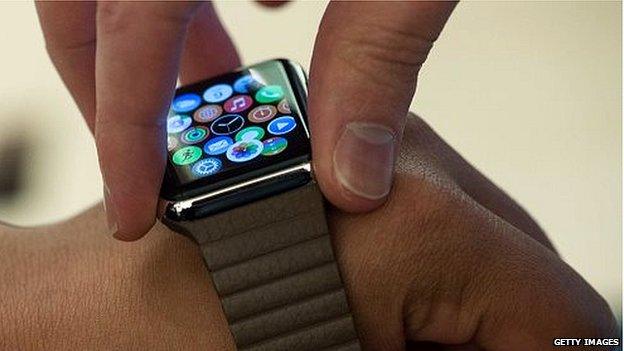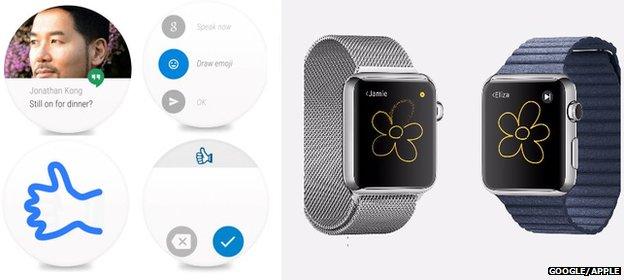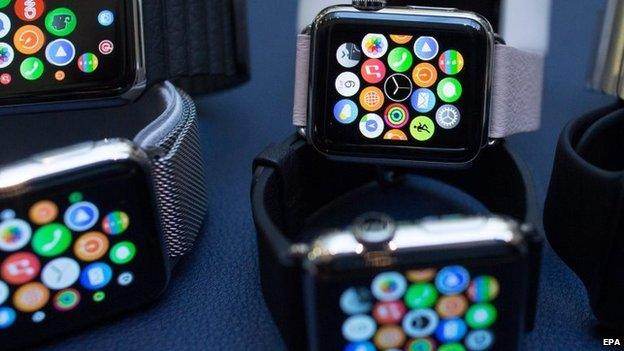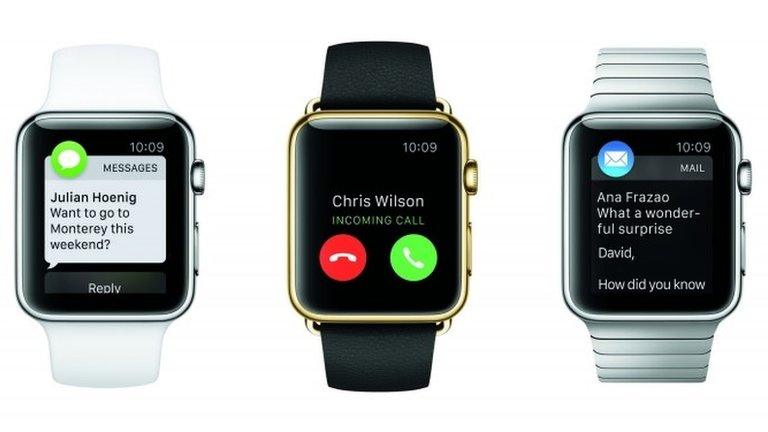Apple Watch: The smartwatch ships, but does it deliver?
- Published

The Apple Watch comes in two sizes and ranges in price from £299 to £13,500
The Watch's release represents a chance for Apple to change the world again with an industry-defining product.
But as launches go, it's the scarcity of the product itself that is perhaps the most remarkable facet.
The firm doesn't yet have enough stock to let its stores sell the smartwatch, and many shoppers who tried to pre-order the device online in the initial hours after it went on sale a fortnight ago have been told that they must wait until May or June for their deliveries.
Those who do receive the first batch today will only get a taste of the Watch's full potential. For now, most third-party apps will depend on a wirelessly-linked iPhone for processing power because Apple hasn't yet allowed them to run natively.
Even so, early indications suggest the US firm has another hit on its hands.
"We are raising our Apple Watch shipment estimates for 2015 from 17 million units to 20 million units, as we estimate sales of over two million units during the pre-sales phase alone, and believe watch revenues could contribute as much as 8% of [Apple's] total revenue in 2017," wrote Daniel Ives from FBR Capital Markets in a note to investors earlier this week.
Early reviews have also praised Apple for creating the best smartwatch yet.
A subsequent update to Google's rival Android Wear software will have eroded some of that lead, external.

An Android Wear update allows users to send each other drawn emojis, similar to the Apple Watch's Sketch function
But the Watch retains unique features.
They include the taptic engine, which uses a vibration motor to create different strengths and patterns of taps on a user's wrist.
And the digital crown, which can be twisted to control the machine as an alternative to swiping across its small screen.
To mark the launch, the BBC asked four experts to provide different takes on its potential impact.

Apple's Watch is the first new category of products to have been launched by its chief executive Tim Cook
Carolina Milanesi - Why the Watch is important to Apple
Chief of research, Kantar Worldpanel ComTech
Since the launch of Apple Watch, everyone looking at the industry wants an answer to the question: How many will Apple be able to sell?
Of course, sales are a quick and easy measure of success but, as with the iPhone, looking for market share alone may not present a full picture of what Apple could achieve with this device.
We have already seen how the go-to-market strategy for the Watch is different to anything Apple has done so far. In my opinion, this strategy is not an effort to maintain the luxury status of the device.
Rather, it aims to learn about consumer preferences so that production of the different models can be tweaked to better meet demand.
The role that online plays in the go-to-market strategy also shows Apple's desire - and need - to grow its online strength.
This will help offload some in-store traffic, which should lead to better customer service.
It also enables Apple to gather information on a larger number of customers, since many do not have access to a physical Apple Store and would have otherwise gone through a traditional retailer.
In addition, the Watch will help Apple strengthen its installed base by locking in customers, since it requires them to own, or at least use, an iPhone as well.
Considering that, according to our surveys, 20% of UK Android users and 67% of French Android users would consider changing from Google's operating system to Apple's to buy the smartwatch of choice, Apple Watch represents a hook into its ecosystem as well.

A range of wristbands could prove a lucrative source of additional revenues for Apple
Scott Stein - Better than the competition, but is the Watch good enough?
Senior editor, Cnet
The world of wearables is a market full of middling products.
The Apple Watch debuts as the most polished, high-design smartwatch yet, with an extremely ambitious feature set. But what it does, in many ways, isn't far off from what other smartwatch platforms like Google's one-year-old Android Wear or Samsung's Gear watches have aimed to do.
However, an already vast army of app developers ready to create for it could end up being the difference-maker.
I've been wearing one for several weeks.
Right now, the Apple Watch is complicated: its interface takes getting used to, it has new ways to interact, and not all of them are intuitive.
You need an iPhone to use it: this isn't truly a standalone product. Third-party apps, which are already here in droves, feel like very early drafts.
Battery life is only a little more than a day. And its price is higher, even at its lowest end, than most of the competition.
It's a first-generation product in a new product line, and it's not a must-buy yet.
Battery life will be hard to fix, but some people may be fine with charging their watch every day.
Software performance, on the other hand, could improve throughout the year. The software from third-party developers feels slow, and sluggish to load data.
Improved app updates, and the launch of more fully connected apps that natively live on the watch, could fix this problem.
The Apple Watch could eventually be a standalone device that works without a phone, someday, but it isn't now and probably won't be for the foreseeable future.
Explaining why people need one, and what they can get out of it, isn't as easy as it was with the iPhone and iPad.
Or maybe, the use cases will emerge over time.
I've found myself frustrated by aspects of Apple Watch as I've worn it. On the other hand, even with its issues, it already has more polished software than any other piece of wearable tech I've seen.
The Apple Watch may sell more and be better recognised than any other piece of wearable tech in history, but it'll take a few years before it really finds its purpose in a transforming world of connected things.

Apple's own Watch apps run natively and can rely on data from a wi-fi hotspot, but third-party apps require the device to be linked to an iPhone
Malcolm Barclay - Don't expect another app economy boom
App developer and consultant
The Apple Watch is arguably an impressive entry into the burgeoning wearable digital devices market.
Along with all the usual players that must have a presence - Facebook, Twitter et al - we are sure to see some ingenious, useful, entertaining and fun watch apps.
However, when contrasted with the early days of the app market, the financial rewards for developers seeking fortunes selling Apple Watch applications alone will be minuscule.
Why? You need an existing iPhone to pair with the Apple Watch in order to run apps; the processing power of the iPhone is leveraged and the output (a view) is displayed on the watch.
Developers are essentially shipping an iPhone application that "extends" itself to the Watch as opposed to installing on it.
An extension alone would have to be something quite special in order to convince users to part with money for it.
Although Apple has announced that developers will be able to create native apps later this year, iPhone pairing will remain necessary.
And native watch apps may be a niche category.
Will they have enough power? What will Apple allow?
Answers to these questions will dictate the market available to developers.
Users' expectations of applications have immeasurably changed since the initial launch days of the App Store.
I once met the developers of a social application that sold virtual ice cubes to their users on a hot day; in turn they would gift them to each other.
Given the plethora of emojis that now ship by default in iOS and Android, this seems laughable today.
Apps now need to be more sophisticated - and costly to produce - to succeed.

Apple's stores and third-party boutiques have allowed some members of the public to try out the device ahead of its release date
Ariel Adams - Much of the traditional watch industry is unprepared
Editor-in-chief, Ablogtowatch.com
Perhaps the most amusing response by the traditional timepiece industry to the Apple Watch is an actual debate as to whether or not this connected "smart" electronic device worn on the wrist can be properly defined as a watch.
In my opinion, such conversations are not only irrelevant but typify the type of legendary conservatism that has helped the traditional watch industry to both thrive and suffer in recent history.
In the late 1970s and early 1980s, the mechanical watch industry was almost decimated thanks to the arrival of cheap, highly accurate electronic quartz watches.
It adapted by focusing on creating mechanical objects of beauty, which are, by many accounts, lovely examples of obsolete technology.
Now that smartwatches are making a play for wrist space, even passionate collectors could stop wearing their traditional counterparts.
In my experience, the traditional watch industry splits its time between ignoring/criticising items like the Apple Watch, debuting less-than-stellar competitive products, and simply acknowledging that while it recognise the potential threat, it lacks the tools and flexibility to properly adapt.
Most troubling for me is that too many people in the traditional watch industry simply don't understand smartwatches - what they do, and what appeal they may have for consumers.
The smartwatch industry struggles to clearly explain why consumers need one.
But at the same time, in my opinion, the traditional watch industry will also struggle because it hasn't taken the time to truly understand what items like the Apple Watch represent for their business.
- Published9 March 2015

- Published11 March 2015

- Published9 March 2015
